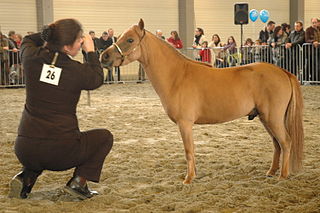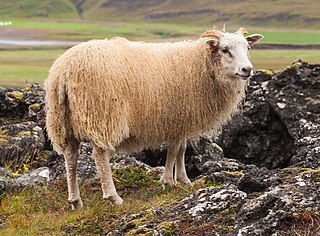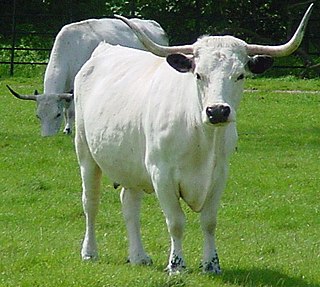
The Texas Longhorn is an American breed of beef cattle, characterized by its long horns, which can span more than 8 ft (2.4 m) from tip to tip. It derives from cattle brought from the Iberian Peninsula to the Americas by Spanish conquistadores from the time of the Second Voyage of Christopher Columbus until about 1512. For hundreds of years the cattle lived a semi-feral existence on the rangelands; they have a higher tolerance of heat and drought than most European breeds. It can be of any color or mix of colors. In some 40% of the cattle it is some shade of red, often a light red; the only shade of red not seen is the deep color typical of the Hereford.
Achondroplasia is a genetic disorder with an autosomal dominant pattern of inheritance whose primary feature is dwarfism. It is the most common cause of dwarfism and affects about 1 in 27,500 people. In those with the condition, the arms and legs are short, while the torso is typically of normal length. Those affected have an average adult height of 131 centimetres for males and 123 centimetres (4 ft) for females. Other features can include an enlarged head with prominent forehead and underdevelopment of the midface. Complications can include sleep apnea or recurrent ear infections. Achondroplasia includes the extremely rare short-limb skeletal dysplasia with severe combined immunodeficiency.

The Munchkin is a breed of cat characterized by its very short legs, which are caused by genetic mutation. Compared to many other cat breeds, it is a relatively new breed, documented since 1940s and officially recognized in 1991. The Munchkin is considered to be the original breed of dwarf cat.

The Highland is a Scottish breed of rustic cattle. It originated in the Scottish Highlands and the Western Islands of Scotland and has long horns and a long shaggy coat. It is a hardy breed, able to withstand the intemperate conditions in the region. The first herd-book dates from 1885; two types – a smaller island type, usually black, and a larger mainland type, usually dun – were registered as a single breed. It is reared primarily for beef, and has been exported to several other countries.

The Aberdeen Angus, sometimes simply Angus, is a Scottish breed of small beef cattle. It derives from cattle native to the counties of Aberdeen, Banff, Kincardine and Angus in north-eastern Scotland. In 2018 the breed accounted for over 17% of the beef production in the United Kingdom.

The Longhorn or British Longhorn is a British breed of beef cattle characterised by long curving horns. It originated in northern England, in the counties of Lancashire, Westmorland and Yorkshire, and later spread to the English Midlands and to Ireland. It was originally a slow heavy draught animal; cows gave a little milk, although high in fat. In the eighteenth century Robert Bakewell applied his methods of selective breeding to these cattle, which for a short time became the predominant British breed. Both the numbers and the quality of the breed declined throughout the nineteenth century and for much of the twentieth. A breed society was formed in 1878, and a herd-book published in that year.

A miniature horse is a breed or type of horse characterised by its small size. Usually it has been bred to display in miniature the physical characteristics of a full-sized horse, but to be little over 100 cm (40 in) in height, or even less. Although such horses have the appearance of small horses, they are genetically much more similar to pony breeds such as the Shetland. They have various colors and coat patterns.

The Kerry Blue Terrier is a breed of dog. Originally bred to control vermin including rats, rabbits, badgers, ferrets, foxes, otters, hares, deer, and even wolves, over time the Kerry became a general working dog used for a variety of jobs including herding cattle and sheep. Despite a Kerry Blue winning Crufts in 2000, it remains an "unfashionable" breed, and is distinctly uncommon; however, it is not as threatened as some of the other terrier breeds such as the Skye Terrier, Sealyham Terrier, and Dandie Dinmont Terrier.

The Dairy Shorthorn is a British breed of dairy cattle. It derives from the Shorthorn cattle of Teesside, in the North Riding of Yorkshire and in Northumbria in north-eastern England. The Shorthorn was for this reason at first known as the Durham or Teeswater.

The Glen of Imaal Terrier is a breed of dog of the terrier category and one of four Irish terrier breeds. It is sometimes called the Irish Glen of Imaal Terrier or the Wicklow Terrier, and the name of the breed is often shortened by fanciers to just Glen.

The South Devon is a British breed of large beef cattle. It originated in the counties of Devon and Cornwall in south-west England, and is mentioned from the eighteenth century. It was a dual-purpose breed, kept both for its milk and for beef. Since 1972 selection has been for beef only.

The Icelandic is the Icelandic breed of domestic sheep. It belongs to the Northern European Short-tailed group of sheep, and is larger than most breeds in that group.

Cerebellar abiotrophy (CA), also called cerebellar cortical abiotrophy (CCA), is a genetic neurological disease in animals, best known to affect certain breeds of horses, dogs and cats. It can also develop in humans. It develops when the neurons known as Purkinje cells, located in the cerebellum of the brain, begin to die off. These cells affect balance and coordination. They have a critical role to play in the brain. The Purkinje layer allows communication between the granular and molecular cortical layers in the cerebellum. Put simply, without Purkinje cells, an animal loses its sense of space and distance, making balance and coordination difficult. People with damage to the cerebellum can experience symptoms like unsteady gait, poor muscle control, and trouble speaking or swallowing.

The White Park is a modern British breed of cattle. It was established in 1973 to include several herds or populations of colour-pointed white cattle – white-coated, with points of either red or black on the ears and feet. Such cattle have a long history in the British Isles, and the origins of some herds go back to the Middle Ages.

The Australian Lowline is a modern Australian breed of small, polled beef cattle. It was the result of a selective breeding experiment using black Aberdeen Angus cattle at the Agricultural Research Centre of the Department of Agriculture of New South Wales at Trangie. It is among the smallest breeds of cattle, but is not a dwarf breed.

The Sussex is a British breed of red beef cattle from the Weald of Sussex, Surrey and Kent, in south-eastern England. Its traditional use as a draught ox on the Weald continued into the twentieth century. From the late nineteenth century it began to be selectively bred for beef production. It has been exported to many countries of the world; the largest population is in South Africa, where there may be half a million head.

A dwarf cat is a domestic cat with dwarfism due to rare genetic mutations causing a disproportionate feline body and significant health problems. Unlike undersized cats of normal proportions, dwarf cats suffer from the genetic mutations osteochondrodysplasia and achondroplasia. These genetic disorders of bone and cartilage are typically manifested as abnormal bone shape, poor growth or lack of growth, bowing of the limbs to the side – front legs are more likely to be affected, and spinal malformations.

The Parthenaise is a French breed of beef cattle. It is named for the town of Parthenay in the département of Deux-Sèvres, in the Nouvelle-Aquitaine region of western France. It was formerly a triple-purpose breed, raised for milk, meat and draught work, but is now raised mainly for beef.

The Lincoln Red is a British breed of red-coated beef cattle. It originates in, and is named for, the county of Lincolnshire in the eastern Midlands of England. It was selectively bred in the late eighteenth and early nineteenth centuries by crossing large local draught cattle of the region with Teeswater Shorthorns of medium size. It was at first known as the Lincolnshire Red Shorthorn, and was a dual-purpose breed, reared both for milk and for beef. The polling gene was introduced in the early twentieth century, and the cattle are now usually polled; the word 'shorthorn' was dropped from the breed name in 1960. In the twenty-first century it is reared for beef.
Miniature cattle are found in various parts of the world. Some, such as the Dexter of Ireland and the Vechur of Kerala, India, are traditional breeds; others have been created by selective breeding. The Australian Lowline was the unexpected result of a scientific experiment. Some, but not all, miniature breeds display achondroplasia, or dwarfism.






















